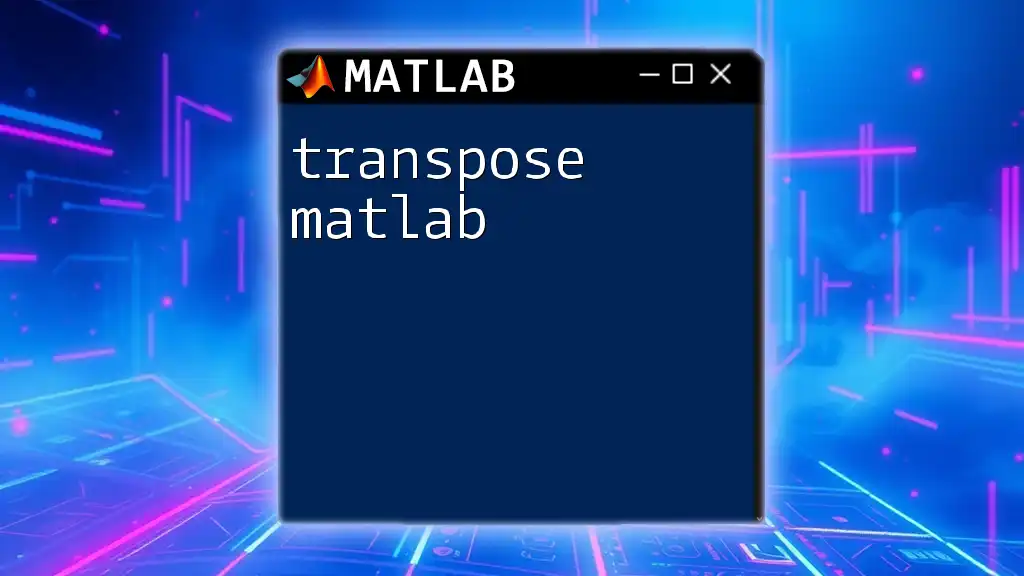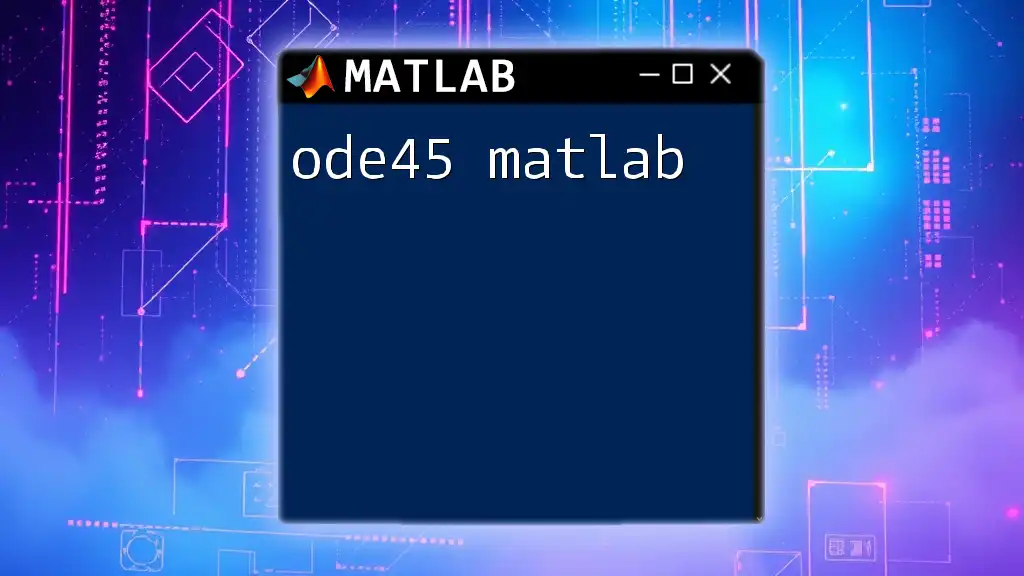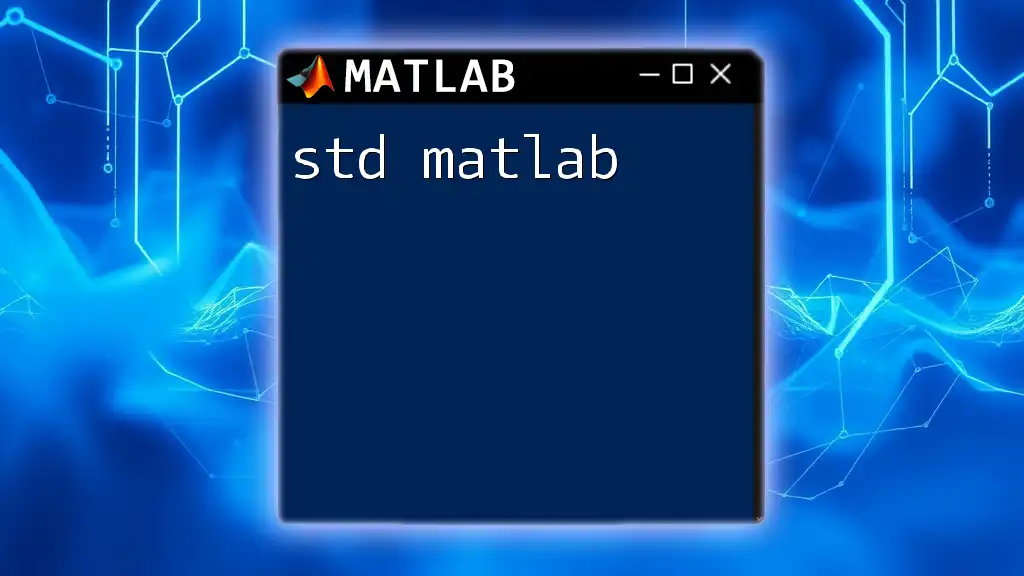In MATLAB, Ordinary Differential Equations (ODE) can be solved using built-in functions like `ode45`, which is especially useful for solving non-stiff differential equations.
Here's a simple example of using `ode45` to solve the differential equation dy/dt = -2y:
% Define the differential equation as a function
odefun = @(t, y) -2 * y;
% Set the time span and initial condition
tspan = [0 5];
y0 = 1;
% Solve the ODE using ode45
[t, y] = ode45(odefun, tspan, y0);
% Plot the results
plot(t, y);
xlabel('Time t');
ylabel('Solution y');
title('Solution of dy/dt = -2y');
What are Ordinary Differential Equations?
An Ordinary Differential Equation (ODE) is an equation that relates a function of one variable to its derivatives. The fundamental purpose of an ODE is to model various phenomena in the real world—spanning fields such as engineering, physics, biology, and economics.
ODEs can be categorized into different types, including:
-
First-Order ODEs: Involves the first derivative of the function. For instance, a simple linear first-order ODE could be expressed as: \[ \frac{dy}{dt} = ky \]
-
Second-Order ODEs: Involves up to the second derivative. An example might look like: \[ \frac{d^2y}{dt^2} + \omega^2 y = 0 \]
-
Higher-Order ODEs: Involves derivatives of order greater than two.
Moreover, ODEs can be classified as initial value problems (IVPs), where the value of the function is specified at a particular point, or boundary value problems (BVPs), where the values are given at two or more different points.

Why Use MATLAB for ODEs?
MATLAB is a powerful tool for solving ODEs owing to its user-friendly interface and built-in functions that simplify complex computations. Some notable advantages include:
-
Numerical Computation: MATLAB provides robust algorithms that are efficient for evaluating ODEs that cannot be solved analytically.
-
Built-In Functions: MATLAB's ODE solver functions, such as `ode45`, `ode23`, and others, are tailored to tackle different types of ODEs effectively.
-
Visualization: The plotting capabilities in MATLAB allow users to visualize solutions, helping to understand the dynamics of the system represented by the ODE.

Getting Started with ODEs in MATLAB
Before diving into ODE solutions, ensure that your MATLAB environment is set up correctly. You may need to install specific toolboxes (such as the MATLAB ODE Toolbox) to leverage advanced functionalities.
Once set up, familiarize yourself with MATLAB’s syntax. Below is a basic structure for writing functions in MATLAB, which is essential for ODE definitions.
function dydt = myODE(t, y)
dydt = -2 * y + t; % A simple linear ODE
end

Basic MATLAB Commands for ODEs
Defining an ODE
In MATLAB, defining an ODE involves creating a function that outputs the derivative values. The function must accept at least two parameters: the independent variable (often time) and the dependent variable.
Using the `ode45` Function
The `ode45` function is one of the most commonly used solvers in MATLAB for first-order ODEs. The syntax is straightforward:
ode45(odefun, tspan, y0)
Where:
- `odefun` is your function that defines the ODE.
- `tspan` is the interval over which you want to solve the ODE.
- `y0` represents the initial condition.
Consider the following example to showcase the effectiveness of `ode45`:
tspan = [0 5]; % Define the time range
y0 = 1; % Initial condition
[t, y] = ode45(@myODE, tspan, y0); % Call to ode45
plot(t, y); % Plotting the results
In this example, MATLAB computes the solution over the interval from 0 to 5, starting at \( y(0) = 1 \). The resulting plot will visualize how \( y \) evolves over time under the influence of the ODE defined in `myODE`.
Exploring Other ODE Solvers
MATLAB offers several other solvers suited for different scenarios:
- `ode23`: A lower-order method suited for less demanding problems.
- `ode15s`: Best for stiff problems where different scales of behavior exist.
- `ode113`: A variable-order solver that can adapt its order based on the properties of the ODE.
Understanding when to use which solver is essential for improving computational efficiency. For a quick reference, here is a comparison table of the solvers based on problem types:
| Solver | Best For |
|---|---|
| `ode45` | General-purpose problems |
| `ode23` | Problems requiring lower precision |
| `ode15s` | Stiff ODEs |
| `ode113` | Highly accurate solutions |

Solving Systems of ODEs
Defining a System
When dealing with systems of ODEs, you'll typically define a function that outputs a vector of derivatives.
Consider a simple example involving two equations:
function dy = mySystem(t, y)
dy = zeros(2, 1); % Preparing a vector for the derivatives
dy(1) = y(2); % First equation
dy(2) = -9.8; % Second equation (like free fall)
end
Solving the System
Using `ode45`, you can solve this system just as easily as a single ODE:
tspan = [0 10];
y0 = [0; 0]; % Initial conditions, e.g., position and velocity
[t, y] = ode45(@mySystem, tspan, y0); % Solving the system
plot(t, y(:, 1), 'r', t, y(:, 2), 'b'); % Plotting results
In this case, `y(:,1)` represents the position, and `y(:,2)` represents the velocity, allowing full dynamics to be visualized.

Advanced ODE Techniques
Event Handling
When solving ODEs, you might need to stop the integration when a specific condition is met (e.g., a with an impact event). You can do this with event detection.
Here’s how you might set that up:
options = odeset('Events', @myEventFunction);
[t, y, te, ye, ie] = ode45(@myODE, tspan, y0, options);
In this code, `myEventFunction` defines the conditions under which you want an event to trigger.
Nonlinear ODEs
Nonlinear ODEs present additional challenges but can be tackled in a similar manner to linear ODEs. Here’s a brief example of a simple nonlinear ODE:
function dydt = nonlinearODE(t, y)
dydt = y^2 - t; % Nonlinear equation
end
Parameter Estimation from ODEs
Parameter estimation is critical in effectively modeling real-world systems. MATLAB includes functions that facilitate fitting parameters of an ODE to experimental data, providing an essential tool for researchers and engineers.

Visualization and Analysis of ODE Solutions
Visualization is paramount for understanding ODE solutions. MATLAB’s plotting functions allow for highly customizable visual outputs.
To effectively utilize these functions:
- Use `plot` for basic line plots.
- Label your axes with `xlabel` and `ylabel`.
- Consider adding legends and titles to make your visuals more informative.
For instance:
plot(t, y);
xlabel('Time');
ylabel('Solution y');
title('Solution of ODE');
legend('y(t)');
Each of these additions enhances the readability and interpretability of your plots.

Common Mistakes to Avoid
When using `ode matlab`, you may encounter several typical pitfalls. Ensure you:
- Correctly Specify Initial Conditions: Incorrect initial values can lead to no solutions or nonsensical results.
- Choose the Right Solver: Using a complex solver for simple problems can lead to unnecessary computation time.
- Understand the ODE Characteristics: Not all ODEs behave in the same way. Knowing whether your problem is stiff or nonlinear will influence your approach significantly.
- Manage Runtime Errors: Break down your code into simpler parts to isolate problems effectively.

Conclusion
In conclusion, mastering ODE solutions in MATLAB is essential for both students and professionals. The ability to model, analyze, and visualize systems represented by ODEs can be the difference between theoretical knowledge and practical application. As you continue exploring the capabilities of MATLAB with ODEs, remember to utilize available resources fully, engage with community forums, and practice consistently.

Additional Resources
For further learning, explore the official MATLAB documentation on ODEs, recommended textbooks, and join forums to immerse yourself in the vibrant MATLAB community. You will find ongoing discussions and shared projects that can significantly enhance your understanding and proficiency with ODEs in MATLAB.

















